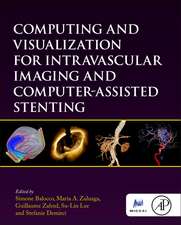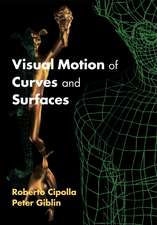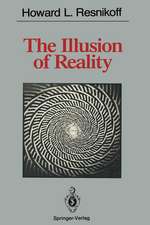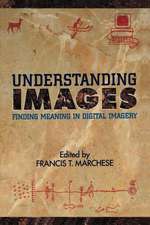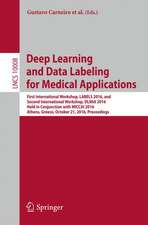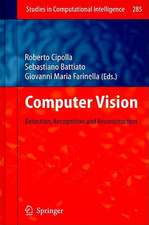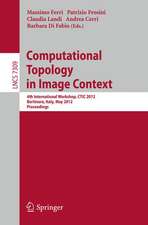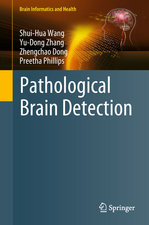Computer Vision - ECCV '96: Fourth European Conference on Computer Vision, Cambridge, UK April 14-18, 1996. Proceedings, Volume II: Lecture Notes in Computer Science, cartea 1065
Editat de Bernard Buxton, Roberto Cipollaen Limba Engleză Paperback – 4 apr 1996
The papers in volume II are grouped in sections on color vision and shading; image features; motion; medical applications; tracking; applications and recognition; calibration, focus, and optics; applications; and structure from motion.
| Toate formatele și edițiile | Preț | Express |
|---|---|---|
| Paperback (2) | 667.89 lei 43-57 zile | |
| Springer Berlin, Heidelberg – 4 apr 1996 | 667.89 lei 43-57 zile | |
| Springer Berlin, Heidelberg – 4 apr 1996 | 668.07 lei 43-57 zile |
Din seria Lecture Notes in Computer Science
- 20%
 Preț: 1061.55 lei
Preț: 1061.55 lei - 20%
 Preț: 307.71 lei
Preț: 307.71 lei - 20%
 Preț: 438.69 lei
Preț: 438.69 lei - 20%
 Preț: 579.30 lei
Preț: 579.30 lei -
 Preț: 410.88 lei
Preț: 410.88 lei - 17%
 Preț: 427.22 lei
Preț: 427.22 lei - 20%
 Preț: 596.46 lei
Preț: 596.46 lei - 15%
 Preț: 448.04 lei
Preț: 448.04 lei - 20%
 Preț: 353.50 lei
Preț: 353.50 lei -
 Preț: 389.49 lei
Preț: 389.49 lei - 20%
 Preț: 309.90 lei
Preț: 309.90 lei - 20%
 Preț: 645.28 lei
Preț: 645.28 lei - 20%
 Preț: 763.23 lei
Preț: 763.23 lei - 15%
 Preț: 580.46 lei
Preț: 580.46 lei - 20%
 Preț: 310.28 lei
Preț: 310.28 lei - 20%
 Preț: 655.02 lei
Preț: 655.02 lei - 20%
 Preț: 1183.14 lei
Preț: 1183.14 lei - 20%
 Preț: 340.32 lei
Preț: 340.32 lei -
 Preț: 449.57 lei
Preț: 449.57 lei - 20%
 Preț: 591.51 lei
Preț: 591.51 lei - 18%
 Preț: 938.83 lei
Preț: 938.83 lei - 20%
 Preț: 337.00 lei
Preț: 337.00 lei - 20%
 Preț: 649.50 lei
Preț: 649.50 lei - 20%
 Preț: 607.40 lei
Preț: 607.40 lei - 20%
 Preț: 1414.79 lei
Preț: 1414.79 lei - 20%
 Preț: 1024.44 lei
Preț: 1024.44 lei - 20%
 Preț: 583.40 lei
Preț: 583.40 lei - 20%
 Preț: 453.32 lei
Preț: 453.32 lei - 20%
 Preț: 575.49 lei
Preț: 575.49 lei - 20%
 Preț: 1075.26 lei
Preț: 1075.26 lei - 20%
 Preț: 585.88 lei
Preț: 585.88 lei - 20%
 Preț: 825.93 lei
Preț: 825.93 lei - 17%
 Preț: 360.20 lei
Preț: 360.20 lei - 20%
 Preț: 763.23 lei
Preț: 763.23 lei - 20%
 Preț: 340.32 lei
Preț: 340.32 lei - 20%
 Preț: 504.58 lei
Preț: 504.58 lei - 20%
 Preț: 369.13 lei
Preț: 369.13 lei - 20%
 Preț: 580.93 lei
Preț: 580.93 lei - 20%
 Preț: 343.62 lei
Preț: 343.62 lei - 20%
 Preț: 350.21 lei
Preț: 350.21 lei - 20%
 Preț: 583.40 lei
Preț: 583.40 lei - 20%
 Preț: 583.40 lei
Preț: 583.40 lei - 15%
 Preț: 438.59 lei
Preț: 438.59 lei - 20%
 Preț: 341.95 lei
Preț: 341.95 lei - 20%
 Preț: 238.01 lei
Preț: 238.01 lei - 20%
 Preț: 538.30 lei
Preț: 538.30 lei
Preț: 667.89 lei
Preț vechi: 834.87 lei
-20% Nou
Puncte Express: 1002
Preț estimativ în valută:
127.84€ • 138.91$ • 107.46£
127.84€ • 138.91$ • 107.46£
Carte tipărită la comandă
Livrare economică 21 aprilie-05 mai
Preluare comenzi: 021 569.72.76
Specificații
ISBN-13: 9783540611233
ISBN-10: 3540611231
Pagini: 752
Ilustrații: XXII, 730 p.
Dimensiuni: 155 x 235 x 39 mm
Greutate: 1.03 kg
Ediția:1996
Editura: Springer Berlin, Heidelberg
Colecția Springer
Seria Lecture Notes in Computer Science
Locul publicării:Berlin, Heidelberg, Germany
ISBN-10: 3540611231
Pagini: 752
Ilustrații: XXII, 730 p.
Dimensiuni: 155 x 235 x 39 mm
Greutate: 1.03 kg
Ediția:1996
Editura: Springer Berlin, Heidelberg
Colecția Springer
Seria Lecture Notes in Computer Science
Locul publicării:Berlin, Heidelberg, Germany
Public țintă
ResearchCuprins
Colour constancy for scenes with varying illumination.- Color angular indexing.- Bidirectional reflection distribution function expressed in terms of surface scattering modes.- Generalizing Lambert's Law for smooth surfaces.- Local scale control for edge detection and blur estimation.- Regularization, scale-space, and edge detection filters.- Direct differential range estimation using optical masks.- Generalised epipolar constraints.- Object models from contour sequences.- Directions of motion fields are hardly ever ambiguous.- Euclidean reconstruction: From paraperspective to perspective.- Optical flow and phase portrait methods for environmental satellite image sequences.- Refinement of optical flow estimation and detection of motion edges.- Reliable extraction of the camera motion using constraints on the epipole.- Accuracy vs. efficiency trade-offs in optical flow algorithms.- Rigorous bounds for two-frame structure from motion.- The rank 4 constraint in multiple (?3) view geometry.- Using singular displacements for uncalibrated monocular visual systems.- Duality of multi-point and multi-frame geometry: Fundamental shape matrices and tensors.- On the appropriateness of camera models.- Ground plane motion camera models.- Snakes and splines for tracking non-rigid heart motion.- Local quantitative measurements for cardiac motion analysis.- Application of model based image interpretation methods to diabetic neuropathy.- Global alignment of MR images using a scale based hierarchical model.- Reconstruction of blood vessel networks from x-ray projections and a vascular catalogue.- Combining multiple motion estimates for vehicle tracking.- Visual surveillance monitoring and watching.- A robust active contour model for natural scene contour extraction with automatic thresholding.- A maximum-likelihood approach to visual event classification.- Measures for silhouettes resemblance and representative silhouettes of curved objects.- Real-time lip tracking for audio-visual speech recognition applications.- Matching object models to segments from an optical flow field.- Quantification of articular cartilage from MR images using active shape models.- Direct methods for self-calibration of a moving stereo head.- Dense reconstruction by zooming.- Telecentric optics for computational vision.- Recognition, pose and tracking of modelled polyhedral objects by multi-ocular vision.- Locating objects of varying shape using statistical feature detectors.- Generation of semantic regions from image sequences.- Tracking of occluded vehicles in traffic scenes.- Imposing hard constraints on soft snakes.- X Vision: Combining image warping and geometric constraints for fast visual tracking.- Human body tracking by monocular vision.- Computational perception of scene dynamics.- A filter for visual tracking based on a stochastic model for driver behaviour.- Elastically adaptive deformable models.- Statistical feature modelling for active contours.- Motion deblurring and super-resolution from an image sequence.- Uncalibrated visual tasks via linear interaction.- Finding naked people.- Acquiring visual-motor models for precision manipulation with robot hands.- A system for reconstruction of missing data in image sequences using sampled 3D AR models and MRF motion priors.- Elimination of specular surface-reflectance using polarized and unpolarized light.- Separating real and virtual objects from their overlapping images.- Goal-directed video metrology.- Reconstructing polyhedral models of architectural scenes from photographs.- Algebraic varieties in multiple view geometry.- 3D model acquisition from extended image sequences.- Computing structure and motion of general 3D curves from monocular sequences of perspective images.- A factorization based algorithm for multi-image projective structure and motion.

